The Khan-Lewis Phonological Analysis Second Edition (KLPA-2) works with Goldman-Fristoe 2 to give more comprehensive diagnoses of articulation and use of phonological processes
Khan-Lewis Phonological Analysis | Second Edition
KLPA-2
The Khan-Lewis Phonological Analysis Second Edition (KLPA-2) works with Goldman-Fristoe 2 to give more comprehensive diagnoses of articulation and use of phonological processesChoose from our formats
Kits
Starter & complete kits, print & digital
1 option
Test forms & reports
Booklets, record forms, answer sheets, report usages & subscriptions
1 option
Support materials
Manuals, stimulus books, replacement items & other materials
1 option
All products
All tests and materials offered for KLPA-2
3 options
